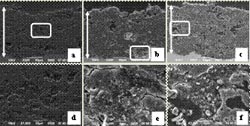Aluminum nitride coatings by atmospheric reactive plasma spray

SEM cross section images of the AlN coatings fabricated with using N2 plasma gas flow rate of: (a) 100, (b) 120, (c) 160 l/min and (d-f) are higher magnifications of the squared parts in (a-c).
For such applications fabrication of thick AlN coating by thermal spray into the chosen material surface considered to be suitable solution. However, it is impossible to fabricate AlN coating directly by conventional thermal spraying due to the AlN thermal decomposition without melting.
Here, Mohammed Shahien and colleagues at Toyohashi University of Technology, Japan report on the realization of cubic AlN coatings on steel substrates by atmospheric reactive plasma spraying of fine Al2O3 feedstock powder in N2/H2 plasma.
The formation process was clarified thus, during spray the particles melted, spheroidized and nitrided in the plasma to form the cubic aluminum oxynitride then cubic-AlN. Furthermore, using smaller particle size enhanced the surface (reaction) area and improved the nitriding conversion.
It was possible to fabricate thick and uniform coatings with high AlN content by spraying fine Al2O3/AlN mixture and the thickness increased from about 150 µm to about 200 µm with increasing the N2 gas flow rate from 100 to 160 l/min.
These results are important for the manufacture of high performance equipment for the materials manufacturing including semiconductors.
Reference
Authors: M. Shahien, M. Yamada, T. Yasui, M. Fukumoto
Title of paper: Aluminum Nitride Coating Fabricated by Reactive Plasma Spraying of Al2O3
Journal: Proceedings of Thermal Spray 2012: Proceedings from the International Thermal Spray Conference and Exposition.May 21–24, 2012, Houston, Texas, USA. Pages: 873-879.
Affiliation: Interface & Surface Fabrication Laboratory, Department of Mechanical Engineering
Media Contact
All latest news from the category: Process Engineering
This special field revolves around processes for modifying material properties (milling, cooling), composition (filtration, distillation) and type (oxidation, hydration).
Valuable information is available on a broad range of technologies including material separation, laser processes, measuring techniques and robot engineering in addition to testing methods and coating and materials analysis processes.
Newest articles

Bringing bio-inspired robots to life
Nebraska researcher Eric Markvicka gets NSF CAREER Award to pursue manufacture of novel materials for soft robotics and stretchable electronics. Engineers are increasingly eager to develop robots that mimic the…

Bella moths use poison to attract mates
Scientists are closer to finding out how. Pyrrolizidine alkaloids are as bitter and toxic as they are hard to pronounce. They’re produced by several different types of plants and are…

AI tool creates ‘synthetic’ images of cells
…for enhanced microscopy analysis. Observing individual cells through microscopes can reveal a range of important cell biological phenomena that frequently play a role in human diseases, but the process of…





















